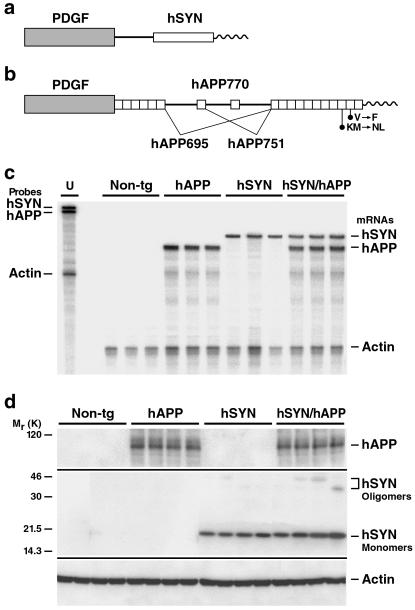Figure 1.
Expression of hSYN and hAPP in brains of tg mice. (a and b) Neuronal expression of a hSYN cDNA (a) and an alternatively spliced hAPP minigene (b) was directed by the human platelet-derived growth factor β-chain promoter as described (17, 23, 25). Elements are not drawn to scale. hSYN/hAPP doubly tg mice were obtained from crosses between previously established lines: hSYN line D (23) and hAPP line J9 (17, 50). Line J9 carries familial Alzheimer's disease (FAD)-linked mutations (670/671KM→NL and 717V→F, hAPP770 numbering) that increase the production of Aβ1–40 and Aβ1–42. (c) Cerebral levels of transgene-derived mRNAs. Total RNA was extracted from hemibrains of 4-month-old mice and analyzed by RNase protection assay. The leftmost lane shows signals of undigested radiolabeled riboprobes (U). The lanes to the right contained the same riboprobes plus brain RNA (10 μg per lane) from different mice, digested with RNases. Protected mRNA segments are identified on the right. Signals were quantitated by phosphorimager analysis: singly and doubly tg mice (n = 3 per genotype) did not differ significantly in hSYN/actin (0.77 ± 0.11 vs. 0.82 ± 0.25) or hAPP/actin (1.60 ± 0.27 vs. 1.33 ± 0.21) ratios (mean ± SD). (d) Cerebral levels of hAPP, hSYN, and mouse actin. Frontal cortex homogenates of 4-month-old mice (n = 4 per genotype) were separated into cytosolic (for hSYN) and particulate (for hAPP) fractions (12 μg per lane), resolved by SDS/10% PAGE, and subjected to Western blot analysis as described (23). hSYN was detected with 72–10 (1:1000) and hAPP with 8E5 (1:2500). Blots were cropped as indicated by horizontal lines. Anti-actin (MAB1501, 1:500) labeling of stripped hSYN (not shown) and hAPP (bottom) blots confirmed equal loading of lanes. Longer exposures of the full-length hSYN blot revealed apparent hSYN oligomers, as well as higher molecular weight hSYN aggregates, in hSYN/hAPP mice and, at much lower levels, also in hSYN singly tg mice (data not shown).

